In the world of digital marketing, few challenges are as frustrating for agencies as managing client expectations around SEO. Many business owners expect SEO to work like a paid ad campaign: immediate results, guaranteed rankings, and exponential growth on a tight budget. When these expectations aren’t met, clients often lose trust, leading to churn and negative word-of-mouth.
But here’s the truth: unrealistic client expectations are not going away anytime soon. What agencies can do, however, is find effective ways to counter them. This is where white label SEO services play a crucial role. By outsourcing SEO to a trusted provider, agencies get the expertise, tools, and data they need to manage expectations and deliver results without burning out their team.
Let’s explore why unrealistic expectations exist, the consequences of not addressing them, and how white label SEO for agencies can turn these challenges into opportunities for long-term client retention.
Why Unrealistic Expectations Exist in SEO?
Agencies often face the same types of client misunderstandings about SEO. Here are the key reasons behind them:
- Information Asymmetry: SEO is technical, and most clients only see the results, not the process. Without insight into the work involved, they underestimate the time and effort required.
- Misinformation Online: Countless “SEO gurus” on YouTube and blogs push guarantees like “Rank #1 in 30 days,” setting unrealistic benchmarks.
- Competitor Pressure: Clients sometimes compare agencies based on false promises, such as another company guaranteeing first-page rankings.
- Budget vs. Outcome Mismatch: Small businesses often expect enterprise-level results while spending at a fraction of the required budget.
- Lack of Upfront Education: Agencies that don’t clearly explain SEO timelines and deliverables often end up dealing with frustrated clients later.
The Consequences of Mismanaged Expectations
When expectations aren’t addressed early, both agencies and clients pay the price.
For Agencies:
- Increased churn and client dissatisfaction.
- Team burnout from chasing impossible promises.
- Damage to long-term credibility.
For Clients:
- Wasted budget on unrealistic goals.
- Frustration and eventual distrust in SEO as a service.
The opportunity lies in bridging this gap. Agencies that educate clients and manage expectations retain business longer and build a reputation for honesty and reliability. White label SEO providers provide agencies with the tools and support to make this possible.
Expectation #1: “We Want Immediate Rankings and Traffic”
The Challenge
Many clients come into SEO with the mindset that, because they’ve seen paid ads get visibility instantly, or read persuasive case studies about rapid jumps in ranking, SEO should operate the same way. This misunderstanding leads to pressure on agencies to “do something fast” — whether or not it’s realistic.
In truth, SEO is often a multistage, cumulative process: technical foundations, on-page content, link authority, user experience, and iterative optimization all need time to gel. According to a recent assessment:
- You can generally expect tangible improvements (impression upticks, ranking shifts, and early traffic) within 3 to 6 months.
- Full competitive breakthroughs (especially in tough niches) often take a year or more.
- Industry ROI studies show that positive ROI from SEO often falls in the 6–12 month window; some niches even have their breakeven in the second or third year.
That disconnect—between client expectations and real search dynamics—is a prime source of frustration.
Provider Solutions
1. Use Forecasting Tools to Show Realistic Timelines (3, 6, 12 Months)
Rather than leaving timelines vague, a white label SEO agency can build forecast models. These models can combine:
- Historical data from similar clients/niches.
- Keyword difficulty vs. existing visibility.
- Domain authority and backlink metrics.
- Market competitiveness and seasonal fluctuations.
Then agencies can present a phased plan:
- Month 1–3: Foundation, technical cleanup, content gap identification.
- Month 4–6: Content rollout, initial link acquisition, early ranking growth.
- Month 7–12: Momentum building, targeting higher volume keywords, compounding gains.
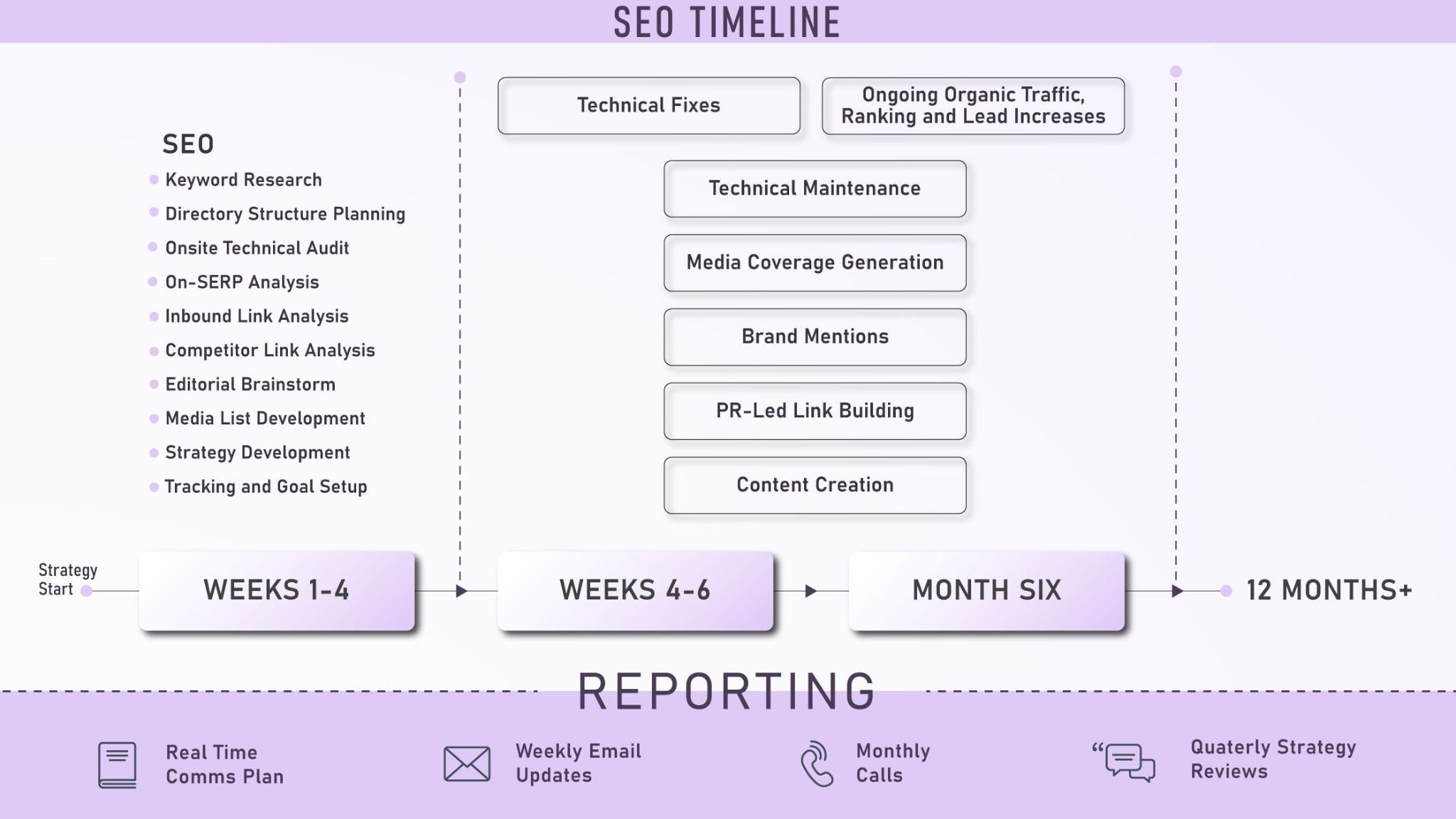
These forecasts set expectations appropriately. By mapping out what “reasonable progress” looks like, both agency and client avoid surprises.
2. Provide Branded Growth Projections for Agencies to Present to Clients
A white label SEO agency can package its forecast into client-ready assets (graphs, visual timelines, midpoint targets) with agency branding. This does two things:
- The agency looks professional and transparent.
- Clients see there is a roadmap, not guesswork.
These visuals become reference points during regular check-ins—“We set this trajectory, here’s where we landed, here’s what’s ahead.”
3. Deliver Early “Quick Wins” to Show Progress While Long-Term Work Unfolds
To keep energy and confidence high, the provider/agency team should aim to deliver early tangible value. Some examples:
- Technical Fixes: correcting crawl errors, removing duplicate content, improving site speed, fixing broken links.
- On-Page Optimizations: title tag tweaks, improving meta descriptions, and internal linking improvements.
- Long-Tail Keyword Wins: targeting less competitive, niche keywords that can start ranking faster.
- UX or Site Structure Improvements: simplifying navigation, enhancing mobile usability.
These quick wins tell clients: “We are working, we are seeing results,” even while the heavy lifting for big-volume ranking gains is still in progress.
By combining forecasts + branded projections + early wins, agencies can better manage the “I want results now” mindset with data, patience, and proof of movement.
Expectation #2: “Can You Guarantee #1 Rankings?”
The Challenge
Clients often demand guarantees like “You’ll get us to the first position for keyword X in six months.” These demands frequently stem from hearing competitors make spectacular promises. But SEO is too unpredictable: algorithm changes, competitor moves, search intent shifts, and external factors all play into ranking.
When agencies accept these guarantees, they risk underdelivery, conflict, and tension. But simply refusing outright may turn clients away, especially if competitor promises look so alluring.
Provider Solutions
1. Position Around Guaranteed Deliverables, Not Guaranteed Rankings
Instead of promising a ranking, promise activities and deliverables you control. For example:
- Number of content pieces published.
- Audits completed.
- Backlink acquisition targets.
- Technical fixes implemented.
These are within your control. You avoid overpromising and still show commitment to execution.
2. Explain Algorithmic Realities and External Uncertainties
Help clients understand that:
- Search engines (especially Google) roll out updates frequently. In fact, Google had core updates in March 2025 and June 2025, each rolled out over weeks.
- Competitors may launch aggressive campaigns at the same time (new content, backlinks, partnerships).
- Search intent can shift (what users look for changes), which can neutralize a seemingly “guaranteed” keyword position.
- Some industries see much higher volatility—healthcare, finance, and legal often have strict rules and algorithm sensitivity.
This doesn’t mean guaranteeing is impossible, but it means clarifying the risk and caveats included in any projection.
3. Use Case Studies Showing Consistent Growth Instead of Unrealistic Promises
Rather than bold claims, provide real examples of steady, predictable growth over 12–24 months. For instance:
- Case studies where ranking improved gradually, month over month.
- Show fluctuations along the way (some gains, some plateaus)—that transparency builds trust.
- Use normalized metrics (traffic growth, conversions) rather than “#1 for everything”.
When clients see that “we cannot promise #1, but here is what we can do—and here’s how it’s worked before”—the conversation shifts from expectations to partnership.
Expectation #3: “SEO Should Be Cheap but Drive Massive Results”
The Challenge
Many clients believe SEO should cost little but deliver massive traffic, leads, and revenue. That’s unrealistic—especially in competitive niches. If budgets are too low, you risk delivering superficial work or underperforming so badly that the client loses faith.
Provider Solutions
1. Offer Industry-Specific Benchmarks (Cost per Lead, ROI by Vertical)
To push back intelligently, providers should bring in data. For example:
- According to FirstPageSage’s 2025 CPL report, organic CPL for legal services averages around $516–$649 (depending on region and scope).
- B2B SaaS organic CPL in that same dataset is around $164, though total blended CPL can go higher.
- SEO generally yields leads that close at - 14.6% conversion rates, whereas outbound methods convert at ~1.7%.
Armed with this data, agencies can say: “In your industry, this is what a realistic lead cost looks like. If your budget is far below that, we need to adjust expectations.”
2. Reframe SEO as a Long-Term Compounding Investment
A key message: SEO isn’t like a fixed ad spend that stops working when your card is cut off. It builds cumulative value over time.
- Many businesses see a 20–30% annual traffic growth when they invest consistently in SEO.
- SEO’s return grows over the years: once content is indexed, links are earned, domain authority strengthens, and each piece of content may continue to drive traffic.
- The break-even point often comes after 6–12 months, but the real payoff often arrives in the second and third year.
Framing this way helps clients see SEO more like a capital investment than a cost.
3. Provide Tiered Service Packages for Realistic Upsells
Structure your white label SEO offering so that agencies can present packages that scale:
- Basic Package: essential technical work, content, and minor link building.
- Mid-Tier Package: more content, more aggressive link building, additional optimization.
- Premium Package: advanced content strategy, PR-level placements, deeper competitor campaigns.
This lets clients pick a level that matches their budget. If they want more results later, you upsell them into the next tier.
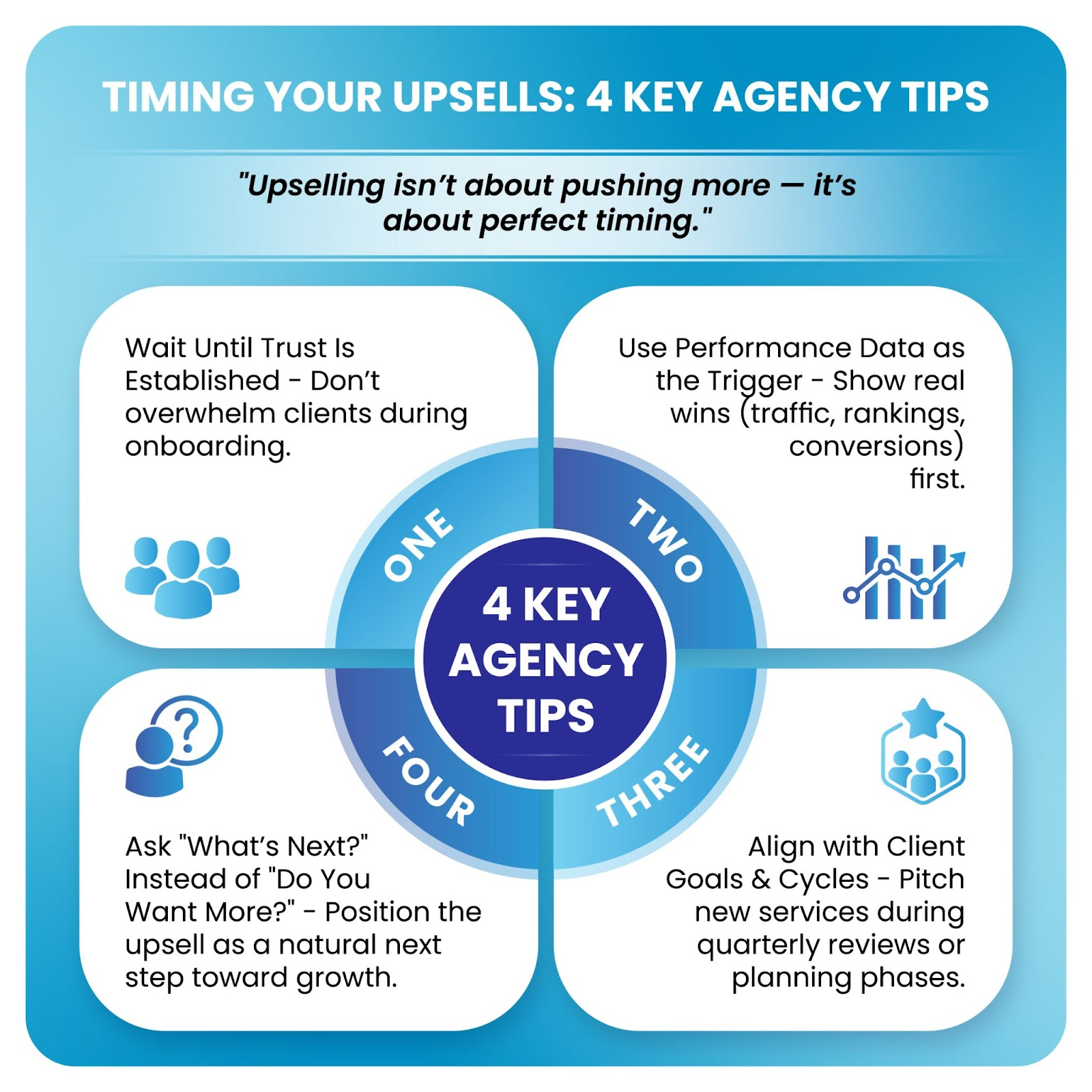
This also helps educate clients: they see what an added budget unlocks in terms of scale and speed.
Further Reading: How Agencies Upsell SEO Packages Without Overpromising
Expectation #4: “We Want to Outrank Big Competitors”
The Challenge
Clients sometimes say, “Why can’t we beat WebMD, HubSpot, Amazon, or other giants in our niche?” That insistence, while ambitious, is rarely practical — especially for newer sites or small businesses with restricted budgets.
Provider Solutions
1. Focus On Niche-Specific Strategies (Local, Long-Tail, Authority Signals)
Giant brands often dominate core, competitive terms. But there are many narrower angles where a smaller client can win:
- Local SEO (if the client serves a region) can yield visibility that major national brands ignore.
- Long-Tail Keywords with lower volume but higher intent may be more accessible.
- Topical Authority Within Subtopics (e.g., deep guides, clusters) can incrementally build domain strength.
By focusing hyper-nicely, the client may get real results rather than fighting an uphill battle.
2. Reframe the Goal: Target Profitable Niches, not Just Volume
Part of the education is helping clients realize that dominating a smaller segment may bring better ROI than chasing volume they can't win. For example:
- If a client is a health clinic, outranking WebMD for a broad “joint pain” keyword may be infeasible. But ranking for “joint pain treatment Chicago” or “knee therapy for seniors in [city]” might deliver paid clients.
- Emphasize that being top in a “narrow, relevant” niche often delivers more qualified leads than being #50 on a broad, high-volume term.
3. Provide Competitive Intelligence Reports to Reset Expectations
White label SEO providers can generate reports comparing your client vs. the big names:
- Domain authority/backlink profile.
- Content depth and structure.
- Keyword overlap and gaps.
- Historical growth trajectories.
When the client sees how deep the gap is, they’re more likely to accept a realistic path. Then the agency can say: “Yes, we can grow you, but here’s what it takes and where we realistically start pushing upward.”
Expectation #5: “SEO is One-Size-Fits-All”
The Challenge
Clients often believe the same SEO blueprint works for all businesses. This assumption leads to disappointment when generic tactics fail to deliver in their niche.
Provider Solutions
1. Use Vertical-Specific Strategies
Different industries need different SEO treatments:
- Healthcare / medical: high need for EE-A-T, compliance, authoritative sources.
- Legal / finance: strong regulatory oversight, reputation, citation strategies.
- SaaS/tech: content funnels, feature pages, integrations, demo pages.
- Local services: citation consistency, local link networks, and Google Business Profile optimization.
A white label SEO provider should be fluent in multiple verticals, so agencies can confidently tell clients: “This is how we’ll tailor it in your niche.”
2. Tailor Campaigns for Compliance, Funnel-Building, or Local Authority
You can show clients examples:
- In healthcare, you might focus on authoritative research, doctor bios, compliant language, and schema for medical conditions.
- For SaaS, you might emphasize content clusters (how-to, tutorials, comparisons) and integration pages.
- For legal, you may emphasize local reviews, local directory presence, citations, and content around case types.
This level of tailoring shows respect for the unique challenges each business faces.
3. Provide Relevant Case Studies (Same Vertical)
Whenever possible, show success stories in that industry. Clients feel more confident when they see similar businesses that have succeeded under comparable conditions. Even if you can’t name a client due to NDA, share anonymized results: “In the legal niche, we increased organic leads 60% in 12 months.”
That reinforces the idea that you understand their world, not just generic SEO.
Expectation #6: “We Don’t Understand What You're Doing with Our Money”
The Challenge
Clients often feel in the dark. If they don’t see precisely what is being done for them, they may assume you’re inactive, overcharging, or delivering low value.
Provider Solutions
1. Provide Branded Dashboards and Reporting
White label SEO providers often include reporting platforms that agencies can rebrand. These dashboards allow clients to see:
- Organic Traffic Trends.
- Keyword Ranking Movements.
- Backlink Growth.
- Content Performance.
- Conversion or Lead Metrics.
This transparency helps the client feel involved and aware.
2. Share Transparent Deliverables (Links, Content, Audits)
Don’t hide the details. Let the client see:
- Which pages had content published?
- Which backlinks were acquired (with quality metrics)?
- Which audits or site changes were made?
- Any SEO tasks scheduled for the upcoming weeks?
This level of detail demystifies SEO. Clients begin to see it as work—not magic.
3. Keep Clients Engaged with Simplified Progress Reports
The trick is to show complex work simply:
- Use visuals (charts, graphs).
- Use short narrative summaries (“This week we fixed 15 crawl errors, published 2 blog posts, earned 3 backlink placements”).
- Tie progress to forecasts or milestones (“We expected +2 ranking positions; we got +1. Next phase targets +3”).
This keeps clients informed without overwhelming them.
Expectation #7: “Can’t SEO Replace All Other Marketing?”
The Challenge
Some clients think that once SEO is running, they can shut down or reduce other marketing channels (PPC, social, and content promotion). They may expect SEO to function like a growth engine that replaces everything else.
Provider Solutions
1. Educate Clients on Seo’s Role in the Marketing Mix
Teach them that SEO is foundational but often slower. It takes time to build, while paid efforts often get faster, immediate results. SEO often works best when combined with:
- Paid Advertising.
- Content Promotion.
- Social media.
- Email Marketing.
SEO should complement—not replace—the existing marketing stack.
2. Show How SEO Integrates with Other Channels
When possible, present integrated strategies:
- Use PPC to test and validate demand before committing to SEO.
- Promote SEO content on social to generate early traffic and shares.
- Use email to nurture leads captured via organic landing pages.
- Retarget organic visitors through paid ads.
When clients see SEO as part of a whole system, they’re less likely to expect it to do everything alone.
3. Offer Bundled Solutions (SEO + PPC, SEO + Content)
If your white label provider offers complementary services (or if the agency itself does), present combined packages. A “SEO + PPC” or “SEO + content promotion” package can:
- Offer immediate traffic (via paid) while SEO ramps.
- Show the synergy between channels.
- Help clients feel they are investing in a balanced marketing strategy.
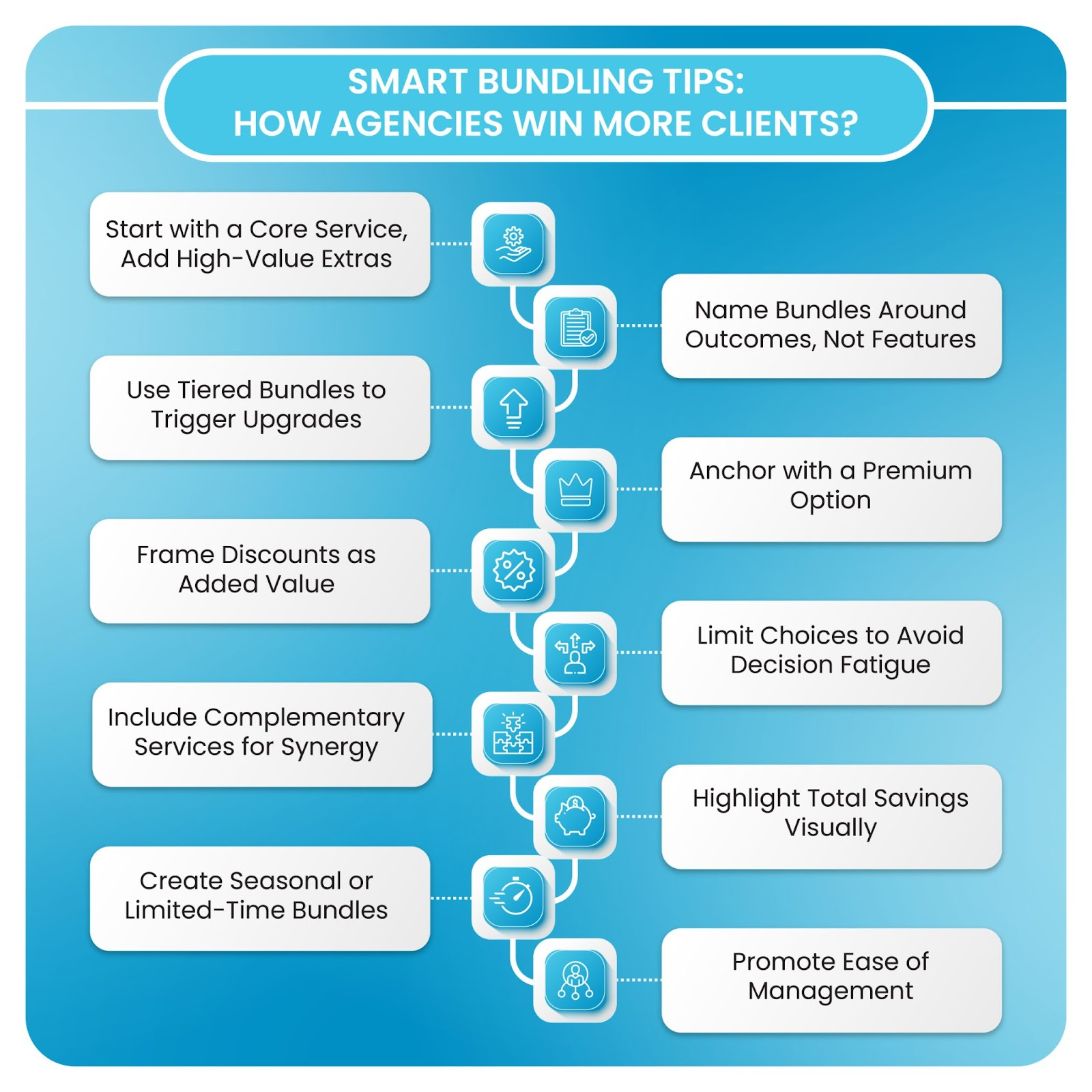
Expectation #8: “Why Haven’t We Seen ROI Yet?”
The Challenge
Clients often become impatient. After 2–3 months, they may ask, “When do we see real returns?” If the agency hasn’t primed them for the fact that large ROI often lags, this question can turn into friction.
Provider Solutions
1. Highlight Micro-Metrics as Leading Indicators
Before revenue is obvious, you can point to:
- Ranking improvements (even small keyword position gains).
- Impression growth (more eyes, even if CTR has not yet peaked).
- Click-through rate (CTR) gains.
- Backlinks earned.
- Content engagement metrics (time on page, bounce, scroll depth).
These show momentum in the pipeline, not just final ROI.
2. Use Quarterly Milestone Resets
Rather than waiting a full year to show ROI, you can plan checkpoints:
- Month 3: ranking & indexation progress.
- Month 6: traffic & lead increase.
- Month 9: pipeline conversion, micro ROI.
- Month 12: more mature ROI.
At each checkpoint, compare actual vs forecasted, adjust strategy, reset expectations.
3. Reframe SEO as a Compounding Asset
It helps to remind clients:
- Early gains feed into later growth (more content, more links, more visibility).
- ROI may look small at first, but cumulative over the years, it becomes significant.
- Many months’ work continues to produce traffic and leads long after the initial effort.
In data from SEO ROI studies, the second and third years often deliver the most dramatic returns.

DashClicks has built its platform specifically to help agencies overcome these common challenges. Through its white label SEO services, agencies get access to forecasting tools, transparent client dashboards, and industry-specific strategies. This makes it easier to set realistic goals, show measurable progress, and maintain trust with clients.
By offering white-labeled reporting and consistent deliverables, DashClicks empowers agencies to spend less time justifying their work and more time building long-term relationships.
Turning Unrealistic Expectations into Long-Term Retention
Unrealistic client expectations are a constant in the SEO industry. The key isn’t trying to eliminate them but learning how to manage them effectively.
With the right white label SEO partner, agencies can:
- Reframe client expectations through data and transparency.
- Deliver early wins while reinforcing long-term strategies.
- Avoid burnout by outsourcing technical work to experts.
The result? Stronger client relationships, better retention, and more predictable growth for agencies.
Unrealistic expectations don’t have to be agency-killers. With the right partner, they can become opportunities to educate, build trust, and deliver lasting value.
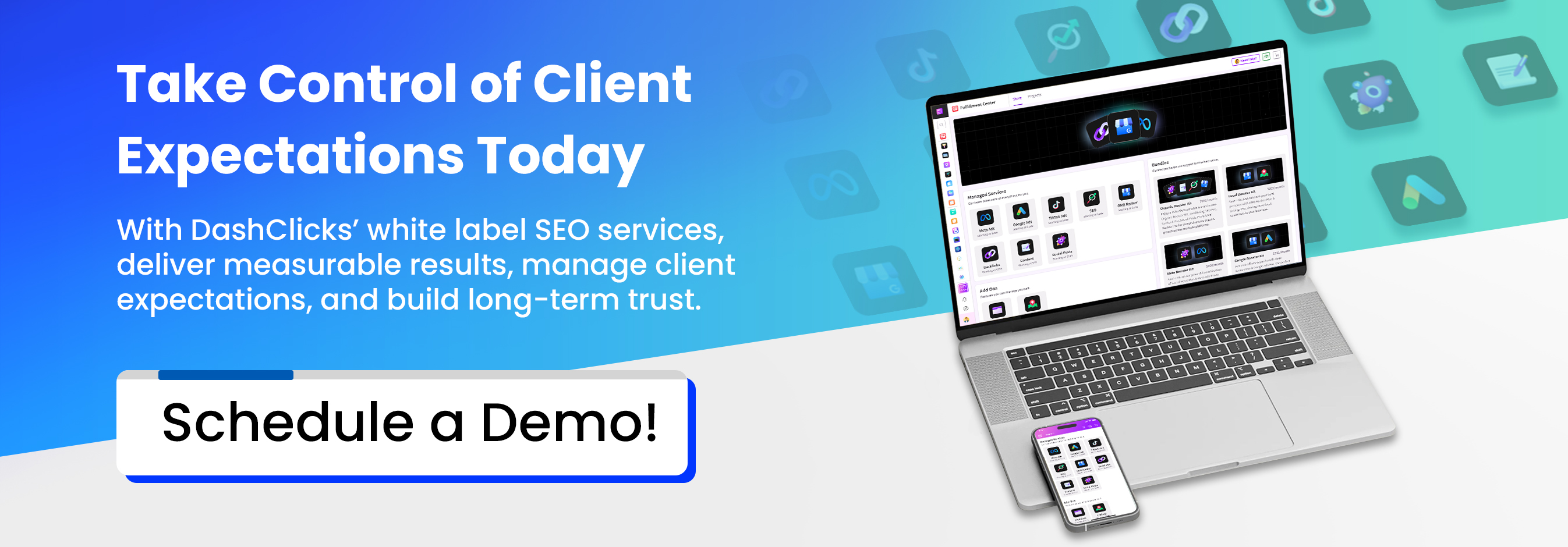


.svg)

.svg)
.svg)
.svg)
.svg)
.svg)
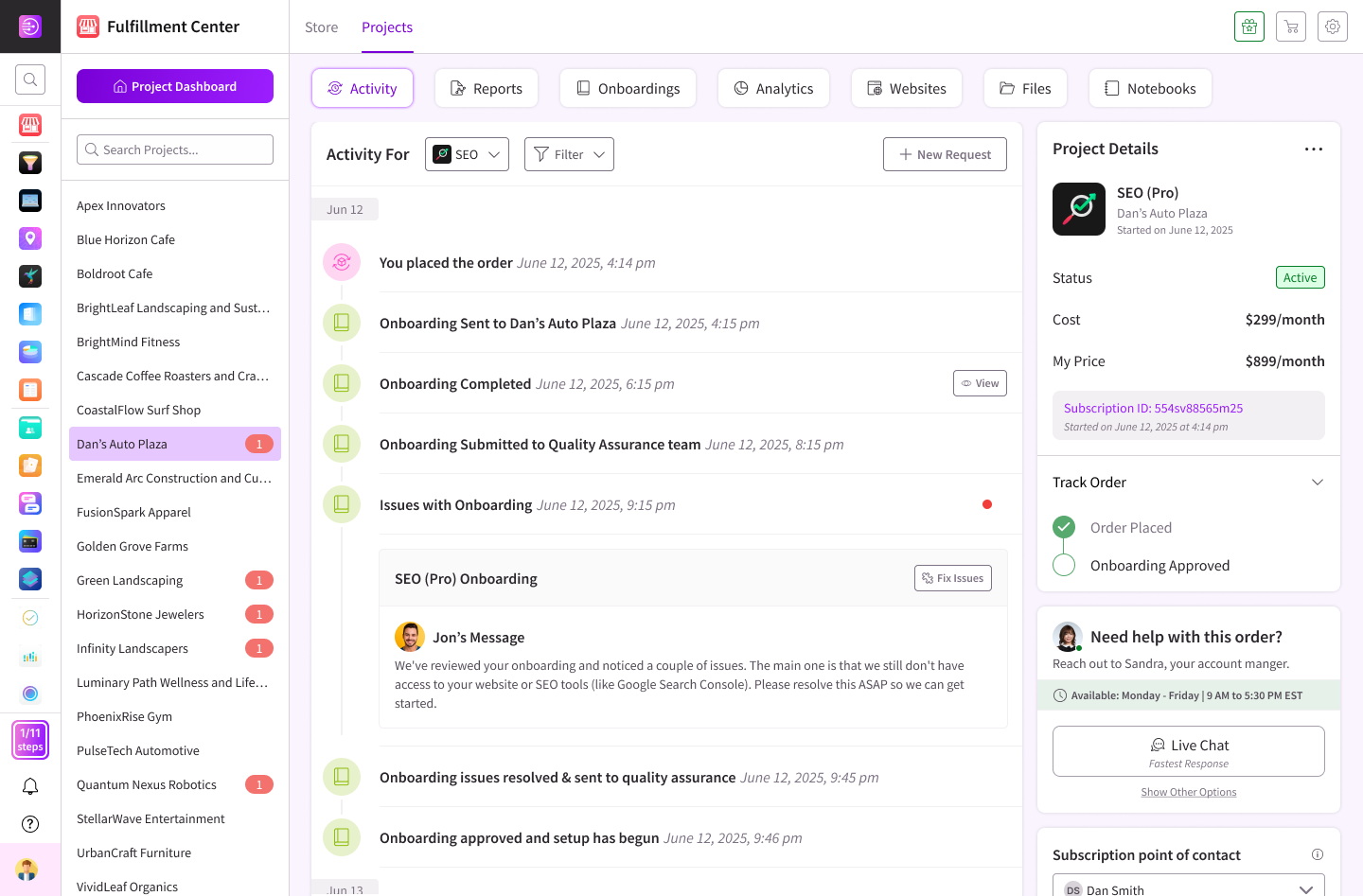
.svg)




.svg)
.svg)
.svg)
.svg)
.svg)